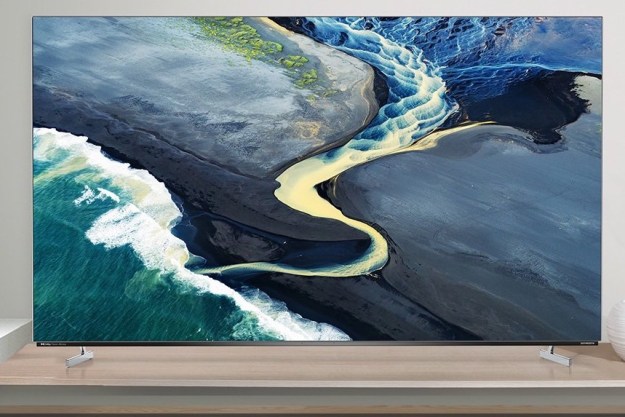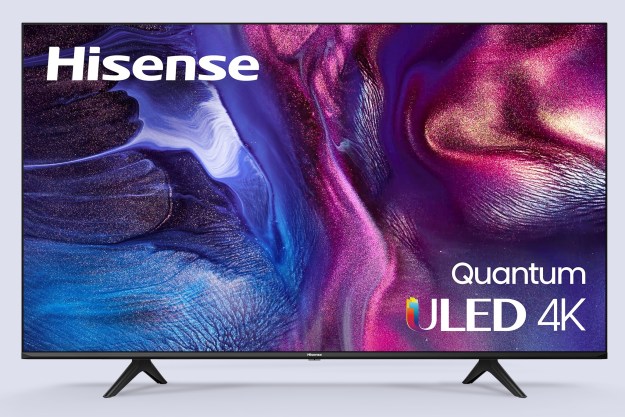As you’ll soon learn, we are reluctant to call a definitive victor in this battle — as far as we’re concerned, both parties in the LG E7 OLED vs. Sony A1E OLED are winners. This is the tightest race between two TVs we’ve ever had, and you may be surprised to learn the deciding factors had nothing to do with picture quality.
Design
Walk into a room with either the LG E7 or Sony A1E OLED sitting in it, and you’re going to take notice. Both TVs demand your attention, each in their own distinctive way. But walk into a room with the two sitting across from each other, and its impossible not to feel a little giddy.
Here at DT headquarters, heads were turned. Folks actually backtracked when they saw us conducting our battle. And we hadn’t even turned the TVs on yet.
- 1. LG E7 OLED
LG’s E7 best shows off how incredibly thin and sleek an OLED TV can look. Taken in from the side, the better part of the E7’s panel is thinner than an iPhone, and from the front, LG’s so-called picture-on-glass approach seems to make the TV’s edges disappear — as if the panel is floating in mid-air. Down below, the LG E7’s integrated soundbar (which is one of the TV’s defining characteristics) makes it clear this TV isn’t phoning it in when it comes to sound quality. The entire package is well supported by an understated pedestal, which is wisely fixed at the center with a minimal footprint. The 65-inch model we tested looks large, but you can place it on just about any entertainment stand.
The Sony A1E OLED doesn’t aim to dazzle with impossible thinness. Instead, Sony has bucked the traditional stand route and opted for an easel-style setup, which allows the TV to rest flush against a surface. The TV ends up looking like a giant, pitch-black picture frame sitting atop a table, and the effect is arresting. The only con to this approach is that the TV does pop out from the wall a bit more than other OLED TVs when wall-mounted. It’s a trade-off we think works, though.
While beauty is always in the eyes of the beholder, we think the Sony A1E OLED is slightly more striking, just edging out the LG in the design category.
Winner: Sony A1E OLED
Sound quality
Since when is sound quality a major bullet point in a top-tier TV battle? Since Sony made the screen itself the speaker system — that’s when! Behind the Sony A1E OLED TV are two sets of actuators which vibrate the OLED panel, creating sound. If it sounds like a gimmick, you may be right, but it is a gimmick that works really well.
If it sounds like a gimmick, you may be right, but it is a gimmick that works really well.
Since the actuated screen isn’t great at producing bass, it gets help from a small “subwoofer” built into the easel-style stand around the back of the television, thus rounding out the sound profile. Perhaps the most prominent effect from this twisted tidbit of engineering, though, is how voices seem to come straight from the mouths of on-screen actors; explosions sound like they are coming from the car or building that is blowing up. Taken in from within 8 feet or so, the sound effects are entertaining. Unfortunately, sit much further from the TV and the impression is lost.
The LG E7 OLED TV’s soundbar may not appear sizable, and it’s not particularly great at producing low tones, but it offers a full, rich sound with plenty of stereo separation. There are better sounding soundbars on the market, and we feel an OLED TV deserves a fancier sound system to do its incredible picture quality justice, but the E7’s on-board sound is better than most. It doesn’t hurt that virtual Dolby Atmos surround sound effects are fairly effective, too.
While Sony’s sound implementation is clever, LG takes this category with a more direct, practical sound solution with higher fidelity.
Winner: LG E7 OLED
User experience
This was an easy decision. LG’s WebOS smart TV system is vastly superior to Sony’s implementation of Android TV. Every one of the five 2017 Sony TVs we tested this year felt sluggish, and we often found ourselves frustrated at slow app loading times, odd-ball hangups, and difficult navigation. Buy a Sony TV for its picture quality, not its smart TV system. Maybe get a Roku instead.
To be fair,
The LG E7’s WebOS system simply works better because it is lightning fast, offers great search, and bounces back and forth between apps like a dream. You can also arrange the order of apps and TV channels to suit your needs, and we’re fans of LG’s motion remote for navigation. In the end, this section of our LG E7 OLED vs. Sony A1E OLED contest was really no contest at all.
Winner: LG E7 OLED
Picture quality
Bottom line: Both of these TVs look incredible. Buy either one and you will be thrilled. Without test patterns and side-by-side viewing for hours, it is virtually impossible to see any meaningful differences between these two televisions.
Under a reviewer’s microscope, one can find each TV exhibits slightly higher performance in some benchmarks. The Sony A1E OLED, for example, exhibits a little less noise and fewer artifacts when displaying compressed cable or satellite TV content than the LG E7 OLED. For all other content, the TVs exhibit very clean pictures.
While the LG E7 OLED does a better job at displaying subtle levels of high brightness for

Color on both televisions is outstanding, and out-of-the-box cinema settings yield excellent results.
Sony does have a slight edge here in motion resolution and motion processing. Both look the same for 24p content coming from standard and 4K Ultra HD Blu-rays, but for cable or satellite TV and streaming content, the Sony manages to pull off smoother motion with less “soap opera effect” involved.
Both TVs do flicker a little bit when bright objects pan across the screen. The intensity of this flicker is less noticeable than on earlier OLEDs, and it is easy to overlook as the overall picture quality is so impressive.
For us, this category is a draw. Both TVs look incredible, and we’re not comfortable saying one TV is superior to the other.
Winner: Draw
Price
Presently, Amazon sells the 55-inch Sony XBR55A1E for $3,000 and the 65-inch XBR65A1E for $4,000. Meanwhile, Amazon sells the 55-inch LG OLED55E7P�for $3,000 and the 65-inch LG OLED65E7P for $4,000. Between these two series, pricing is not a determining factor — at least for the time being.
However, it is worth pointing out that LG B7 series OLED TVs offer identical picture quality for $1,000 less per model, while the LG C7 series OLEDs do the same thing for less as well. If picture quality is the primary concern, and design and sound quality are less important, then LG wins the price wars, hands down.
Still, this is a comparison between the LG E7 OLED vs. Sony A1E OLED, and since the two are essentially the same price per screen size, we have to call this a draw.
Winner: Draw
And the winner is …
Both TVs are outstanding, each appealing to the differing needs and wants of differing viewers, but since we have to name a winner, we’re going to give the extremely narrow victory to the LG E7 OLED. We like the E7’s WebOS user interface quite a bit more than the
Still, the Sony A1E OLED is a marvel of engineering, and absolutely stunning performer, and worthy of serious consideration for any premium TV buyer. Choose either one, and you’re going to be thrilled.
Final Winner: LG E7 OLED
Editors' Recommendations
- LG’s 2024 OLED evo TVs available for preorder and start at $1,500
- Sharp’s promised Roku OLED TV is now available and deeply discounted
- Samsung accidentally reveals price of its 77-inch QD-OLED TV
- LG’s 42-inch LX3 OLED TV can bend when you want it to
- This stunning, folding 4K TV now costs 50% less, but you still can’t afford it






